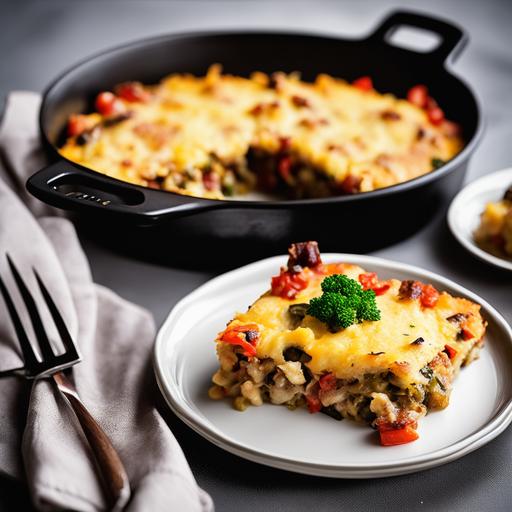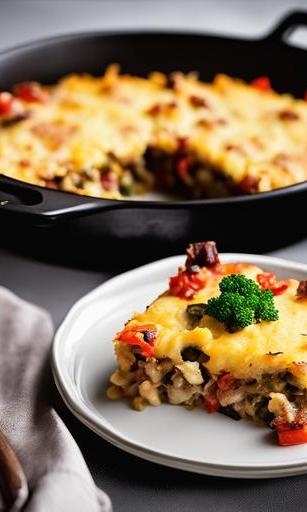
Reheat Casserole In Oven : Step-by-Step Instructions
Casseroles are a beloved comfort food, often prepared in large batches to enjoy over multiple meals. However, reheating a casserole while preserving its flavor and texture can be a bit tricky. While the microwave may seem like the most convenient option, using the oven is often the best way to ensure that the casserole is heated through evenly while maintaining its delicious taste and texture. In this comprehensive guide, we will explore the best practices for reheating a casserole in the oven, including the optimal temperature and cooking time.
Quick Answer: How To Reheat Casserole In Oven
Reheating a casserole in the oven is a straightforward process that yields excellent results. To quickly reheat a casserole in the oven, follow these simple steps:
- Preheat the oven to 350°F (175°C).
- Place the casserole in an oven-safe dish or casserole dish.
- Cover the dish with aluminum foil to prevent the top of the casserole from drying out.
- Place the dish in the preheated oven and heat for 20-30 minutes, or until the casserole is thoroughly heated.
When Not To Reheat Casserole In Oven
While the oven is an excellent method for reheating casseroles, there are certain situations where it may not be the best option. Here are some scenarios in which you may want to consider alternative methods for reheating your casserole:
- Time Constraints: If you need to quickly reheat a small portion of casserole, using the microwave may be more convenient than heating the entire dish in the oven.
- Preservation of Toppings: If your casserole contains delicate toppings, such as cheese or breadcrumbs, reheating it in the oven may cause these toppings to become overly crispy or dry. In such cases, using a lower heat setting or covering the dish with foil can help preserve the toppings.
- Energy Conservation: If you are looking to conserve energy, reheating a single portion of casserole in the microwave may be a more efficient option than heating the entire dish in the oven.
Best Temperature To Reheat Casserole In Oven

The temperature at which you reheat a casserole in the oven plays a crucial role in ensuring that the dish is thoroughly heated without drying out or becoming overcooked. The ideal temperature for reheating most casseroles is 350°F (175°C). This temperature allows for even heating throughout the casserole while preventing the edges from becoming overly crispy or burned.
Best Cooking Time To Reheat Casserole In Oven
Determining the optimal cooking time for reheating a casserole in the oven depends on several factors, including the size of the casserole, its thickness, and its initial temperature. As a general guideline, reheating a casserole in the oven typically takes 20-30 minutes at 350°F (175°C). However, it’s essential to check the casserole periodically to ensure that it is heated through evenly.
Reheating a casserole in the oven is an excellent way to ensure that the dish is thoroughly heated while preserving its flavor and texture. By following the guidelines outlined in this comprehensive guide, you can confidently reheat your favorite casseroles in the oven, knowing that they will come out perfectly reheated and ready to enjoy. With the right temperature, cooking time, and attention to detail, your reheated casserole will taste just as delicious as it did when it was first prepared.
How To Reheat Casserole In Oven
Casseroles are a popular and convenient dish that can be prepared in advance and enjoyed for days. However, when it comes to reheating a casserole, many people are unsure of the best method to use. One of the most effective ways to reheat a casserole is in the oven. Reheating in the oven allows for even and thorough heating, ensuring that the casserole is heated all the way through without compromising its taste and texture.
Reheating a casserole in the oven may take longer than other methods, but it is considered one of the best ways to ensure that the entire dish is evenly heated. Follow these steps to reheat your casserole in the oven:
-
Preheat the oven: Start by preheating your oven to 350°F (175°C), or as specified in your casserole recipe if it requires a different temperature.
-
Prepare the casserole: If the casserole is frozen, let it thaw in the refrigerator overnight to ensure even heating. If it is refrigerated, you can proceed with reheating without thawing. Ensure the casserole is in an oven-safe dish.
-
Cover the casserole: To prevent the casserole from drying out during reheating, cover it with aluminum foil or an oven-safe lid. This will help to trap moisture and retain the flavors.
-
Reheat: Place the covered casserole in the preheated oven and allow it to reheat for approximately 20 to 30 minutes. The exact time will depend on the size and thickness of the casserole. To ensure it is fully reheated, you can use an instant-read thermometer to check that the internal temperature has reached at least 165°F (74°C).
-
Remove the cover: After the casserole has warmed through, remove the foil or lid to allow the top to brown and crisp up if desired. Continue baking for an additional 5-10 minutes, or until the top is golden and crispy.
-
Serve and enjoy: Once the casserole has finished reheating and has reached the desired temperature, carefully remove it from the oven. Allow it to cool for a few minutes before serving.
Should I Reheat Casserole In Oven

Reheating a casserole in the oven is a great option if you want to ensure even and thorough heating. It is especially ideal for casseroles with multiple layers or toppings, as it helps to maintain the integrity of the layers without melting or becoming soggy.
However, reheating in the oven does require more time compared to other methods such as reheating in the microwave. If you’re in a hurry, the microwave might be a more convenient option. However, keep in mind that the microwave might not heat the casserole as evenly as the oven, and the texture may suffer.
Another consideration is the type of casserole you are reheating. Certain casseroles, like lasagna or stuffed pasta, benefit from the dry heat of the oven, which helps to evaporate excess moisture and create a crispy top. On the other hand, casseroles with delicate ingredients or those that require a moist texture may not be suitable for reheating in the oven, as it can cause them to dry out.
In conclusion, whether you should reheat your casserole in the oven depends on the type of casserole, your desired texture, and the amount of time you have available. If you prioritize even heating and maintaining the integrity of the layers or toppings, then reheating in the oven is the best option.
Best Ways To Reheat Casserole
Reheating a casserole in the oven is one of the best ways to ensure even and thorough heating. However, there are a few additional tips and techniques that you can follow to get the best results:
-
Divide the casserole into portions: If you have a large casserole that will not be consumed all at once, consider dividing it into individual portions before reheating. This will not only speed up the reheating process but also make it easier to handle and serve.
-
Add moisture if needed: If your casserole tends to dry out during reheating, you can add a little extra moisture to the dish. This can be done by drizzling some broth or sauce over the casserole before covering it and placing it in the oven. This extra moisture will help keep the casserole moist and flavorful.
-
Use a water bath: To prevent the edges of the casserole from drying out or becoming overcooked, you can place the casserole dish within a larger oven-safe dish filled with water. The water bath will help to regulate the heat and maintain a moist environment. This technique is particularly useful for casseroles with a long reheating time.
-
Consider temperature adjustments: While the general guideline for reheating a casserole in the oven is 350°F (175°C), you may need to make some adjustments depending on the specific recipe. For example, if your casserole has a delicate topping that may burn easily, you can lower the oven temperature to 325°F (160°C) and extend the reheating time.
-
Monitor reheating time: Keep a close eye on the casserole during reheating to ensure it does not overcook or dry out. Each casserole may have different reheating times, so it’s important to check the texture and doneness periodically. Use an instant-read thermometer to check the internal temperature of the casserole to ensure it has reached 165°F (74°C) for food safety.
By following these tips, you can maximize the chances of reheating your casserole to a perfect, delicious state.
What Reheating In Oven Does To The Casserole
Reheating a casserole in the oven has several effects on the dish.
-
Even and thorough heating: The oven allows for consistent and even heating, ensuring that the entire casserole is warmed through. This is especially important for casseroles with multiple layers or toppings, as it helps to maintain the integrity and visual appeal of the dish.
-
Retention of flavors and textures: Reheating in the oven helps to retain the flavors and textures of the casserole. The dry heat of the oven allows excess moisture to evaporate, intensifying the flavors. It also helps to maintain the desired texture, such as a crispy top or a gooey center.
-
Melting and blending of flavors: The longer cooking time in the oven allows the flavors of the casserole to blend and meld together, resulting in a more cohesive and flavorful dish. This is particularly evident in casseroles with complex flavors and ingredients.
-
Browning and crispiness: Reheating in the oven can help create a beautifully browned and crispy top on the casserole. This adds visual appeal and texture to the dish, making it more enjoyable to eat.
-
Risk of drying out: One potential drawback of reheating in the oven is the risk of drying out the casserole, especially if it is left in the oven for too long. To prevent this, it is essential to monitor the reheating process closely and consider the addition of extra moisture if needed.
Overall, reheating a casserole in the oven can bring out the best in the dish, providing even heating, retaining flavors and textures, and creating a visually appealing final result.
Reheating a casserole in the oven is a fantastic way to ensure even and thorough heating, while also maintaining the flavors and textures of the dish. It is especially useful for casseroles with multiple layers or toppings, as it helps to maintain their integrity. While reheating in the oven may take longer compared to other methods, such as the microwave, the results are often worth the wait. With a few extra techniques, such as portioning the casserole, adding moisture if needed, using a water bath, and monitoring the reheating time, you can elevate your reheated casserole to its best potential. So the next time you have leftover casserole, consider reheating it in the oven for a delicious and satisfying meal.
Can You Restore The Initial Quality Of Casserole?

Casseroles are a popular dish that combines various ingredients into one hearty meal. Whether it’s a classic lasagna, a cheesy macaroni and cheese, or a flavorful chicken pot pie, casseroles are known for their delicious flavors and versatility. However, when you have leftovers, reheating them can be a challenge.
Many people wonder if it’s possible to restore the initial quality of a casserole after it has been refrigerated or frozen. While reheating may not necessarily result in the exact same taste and texture as when it was first cooked, there are steps you can take to improve its quality.
One key factor in restoring the initial quality of a casserole is to ensure that it is reheated evenly. This is where the oven comes in handy, as it provides a more consistent distribution of heat compared to other methods like microwaving. Reheating the casserole in the oven allows the flavors to meld together and the ingredients to heat through more uniformly, resulting in a more enjoyable eating experience.
Tips For Optimal Reheating Results
To achieve the best reheating results for your casserole in the oven, consider the following tips:
1. Preheat The Oven
Before placing your casserole in the oven, always preheat it to the appropriate temperature. Preheating ensures that the oven is fully heated and ready to evenly distribute heat to your casserole.
2. Cover The Casserole
Covering the casserole with aluminum foil or a lid during reheating helps to retain moisture and prevent the top from becoming overly dry or burnt. This step is particularly important for casseroles with a breadcrumb or cheese topping that may easily become overcooked.
3. Use An Oven-Safe Dish
Ensure that you are using an oven-safe dish when reheating your casserole. Glass or ceramic dishes are commonly used for casseroles as they distribute heat evenly and can withstand high temperatures. Avoid using plastic or aluminum containers, as they may warp or melt in the oven.
4. Add Moisture If Necessary
If your casserole seems dry after reheating, you can add a bit of moisture to restore its original consistency. This can be done by drizzling some broth, sauce, or even a splash of water over the casserole before placing it in the oven. The added moisture will help prevent the dish from drying out during reheating.
5. Stir And Rotate
To ensure even reheating, stir the casserole occasionally while it is in the oven. This will help distribute any hot or cold spots and ensure that all parts of the casserole are heated through properly. Additionally, consider rotating the dish halfway through the reheating process to promote uniform cooking.
6. Reheat At The Right Temperature And Time
The recommended temperature and time for reheating a casserole in the oven may vary depending on the specific dish and its ingredients. However, a general guideline is to preheat the oven to 350°F (175°C) and reheat the casserole for 20-30 minutes or until it reaches an internal temperature of 165°F (74°C). It is important to check the internal temperature to ensure that any harmful bacteria are eliminated.
Can You Reheat Casserole More Than Once?
While it is technically safe to reheat casserole more than once, it is generally recommended to only reheat it once to maintain its quality and minimize the potential for foodborne illness. Each time the casserole is reheated, there is an increased risk of bacterial growth if it is not reheated properly or stored at the correct temperature.
If you have larger portions of casserole leftover, consider dividing them into smaller portions before reheating. This way, you can reheat only the amount you need, minimizing the likelihood of having leftovers to reheat multiple times.
Safety Measures When Reheating Casserole

It is important to follow safety measures when reheating a casserole to prevent foodborne illnesses. Here are some tips to keep in mind:
1. Refrigerate Properly
After preparing or serving the casserole, it is crucial to refrigerate any leftovers within two hours. Bacteria can grow rapidly at room temperature, and leaving the casserole out for too long increases the risk of food poisoning.
2. Thaw Frozen Casserole Safely
If you have previously frozen your casserole, ensure that you thaw it safely before reheating. The recommended method is to transfer the frozen casserole to the refrigerator and allow it to thaw overnight. Thawing at room temperature can promote bacterial growth and compromise food safety.
3. Store In Appropriate Containers
To maintain the quality and safety of the casserole, store it in airtight, food-grade containers. These containers should be able to withstand freezing and reheating temperatures without warping, melting, or leaching harmful chemicals into the food.
4. Reheat To The Right Temperature
Ensure that your reheated casserole reaches an internal temperature of 165°F (74°C) to kill any potential bacteria. Use a food thermometer to accurately measure the temperature at the thickest part of the casserole.
5. Consume Within A Safe Time Frame
To minimize the risk of foodborne illness, consume reheated casserole within two to three days. If the casserole has been reheated more than once, it is best to consume it within 24 hours to ensure optimal safety and quality.
Reheating casserole in the oven is a great way to restore its initial quality and enjoy it as if it were freshly cooked. By following the tips provided in this article, you can ensure that your reheated casserole retains its flavors, textures, and overall appeal. Remember to prioritize food safety by properly storing and refrigerating leftovers, using appropriate containers, and reheating to the correct internal temperature. With these precautions in place, you can confidently enjoy your reheated casserole without compromising your health or the quality of the dish.
Adjusting Reheating Times
Casseroles are a favorite dish for many people as they are easy to make and can be kept for a few days in the refrigerator. One way to keep them fresh and warm when serving is by reheating them in the oven. However, reheating a casserole in the oven requires the right temperature and careful monitoring to prevent the dish from becoming overcooked or dry.
When reheating casseroles in the oven, the temperature and time duration are the crucial factors that determine the outcome of the dish. Depending on the ingredients in the casserole, you may need to adjust the reheating time and temperature to ensure your dish comes out perfect. Typically, when reheating casseroles in the oven, the temperature and duration should be aligned with the original cooking instructions.
Here are some general tips for reheating casseroles in the oven:
Step 1: Preheat Your Oven
Always preheat the oven to the temperature specified in the recipe to ensure consistent heat throughout the dish.
Step 2: Cover The Casserole Dish
Use a lid or aluminum foil to cover the casserole dish when reheating it in the oven. The cover will help trap the moisture, letting the ingredients reheat and steam efficiently, ensuring the dish remains moist.
Step 3: Reheat The Casserole In The Oven
Place the covered casserole dish in the preheated oven and let it reheat for 15-20 minutes. It would help if you watched the casserole to ensure it does not burn or overcook.
Step 4: Check The Temperature
Check the internal temperature of the casserole with a cooking thermometer. Ensure the temperature reaches at least 165°F, making the dish safe for consumption.
For casseroles that contain raw or undercooked ingredients, it is essential to reheat the casserole at a temperature where the internal temperature of the dish exceeds 165°F. Get a cooking thermometer and place it in the center most part of the casserole for accurate reading.
Avoiding Common Mistakes In Oven Reheating
Reheating casseroles in the oven can also result in some common mistakes that produce less-than-ideal outcomes. To ensure a perfectly reheated casserole, avoid the following errors:
Mistake 1: Overcooking the casseroles
Reheating the casserole in the oven for too long or at a high temperature will cause it to dry out and become overly crisp. The result is a casserole with a burnt crust and a dry center.
Mistake 2: Reheating The Casserole Without A Lid
When you do not cover the casserole dish when reheating, the moisture will escape into the oven, causing the casserole to become dry and less appetizing.
Mistake 3: Defrosting Casserole In The Microwave
If you have kept the casserole in the fridge or freezer, avoid defrosting it in the microwave. Reheating from freezer to oven will yield a dry and tough casserole.
Tips And Tricks To Reheating Casserole In Oven
Here are some tips and tricks for reheating casseroles in the oven that will help you get the best possible results:
Tip 1: Allow The Casserole To Rest
Allow the casserole to rest for 5-10 minutes once you take it out of the oven. Resting gives the casserole time to settle, allowing it to cut and serve easily.
Tip 2: Add More Liquid
Add more liquids like beef, chicken, or vegetable broth to the casserole before reheating it in the oven to keep it moist. Additionally, you can sprinkle some water over the top to help prevent the casserole from drying out.
Tip 3: Preheat The Oven
Ensure that the oven is fully preheated before reheating the casserole to promote even heat distribution.
Tip 4: Use The Correct Ovenware
The kind of ovenware you use to reheat casseroles in the oven matters. It is best to use oven-safe dishes made of ceramic, glass, or stainless steel that can withstand high temperatures.
Conclusion
Reheating casserole in the oven is simple and effective, provided you follow the right temperature and time duration required. While it may seem inconsequential, the way you reheat your casserole can impact the quality of the dish. With the tips and tricks outlined in this article, you can get the best possible results from reheating your casserole in the oven. Finally, ensure you practice food safety when reheating casseroles, ensuring it is fully heated to a safe consumption temperature of 165°F.
FAQS
What Temperature Should I Reheat My Casserole In The Oven?
It is recommended to reheat your casserole in the oven at a temperature of 350 degrees Fahrenheit.
How Long Should I Reheat My Casserole In The Oven?
The reheating time will vary depending on the size and thickness of your casserole. As a general rule, it typically takes 20-30 minutes to reheat a casserole in the oven.
Do I Need To Cover The Casserole When Reheating It In The Oven?
Yes, it is recommended to cover your casserole with aluminum foil to prevent it from drying out while reheating.
Can I Reheat My Casserole In A Glass Dish In The Oven?
Yes, glass dishes are safe to use in the oven for reheating casseroles. However, make sure the dish is oven-safe and can withstand the recommended temperature.
How Can I Tell If My Casserole Is Fully Reheated In The Oven?
Use a food thermometer to ensure that your casserole has reached an internal temperature of 165 degrees Fahrenheit, which is the safe temperature for eating leftovers. Alternatively, you can also insert a knife into the center of the casserole and check if it comes out hot.



